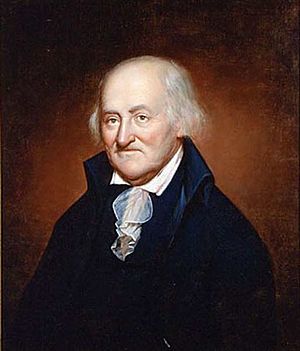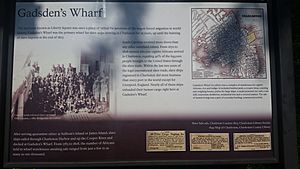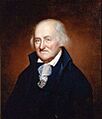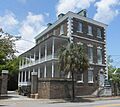Christopher Gadsden facts for kids
Quick facts for kids
Christopher Gadsden
|
|
|---|---|

Portrait by Charles Fraser
|
|
| 7th Lieutenant Governor of South Carolina | |
| In office January 24, 1780 – January 31, 1782 |
|
| Governor | John Rutledge |
| Preceded by | Thomas Bee |
| Succeeded by | Richard Hutson |
| Personal details | |
| Born | February 16, 1724 Charleston, South Carolina, British America |
| Died | August 28, 1805 (aged 81) Charleston, South Carolina, U.S. |
| Relatives | James Gadsden (grandson) |
| Military Service | |
| Allegiance | United States |
| Service/ |
South Carolina Militia, Continental Line, State Troops |
| Years of service | 1776–1777 |
| Rank | Brigadier General |
| Commands held | South Carolina 1st Regiment (Infantry) |
Christopher Gadsden (born February 16, 1724 – died August 28, 1805) was an important American leader. He played a key role in the Patriot movement in South Carolina during the American Revolution.
Gadsden was a delegate to the Continental Congress. He also served as a brigadier general in the Continental Army. Later, he became Lieutenant Governor of South Carolina. He was a successful merchant and is famous for designing the Gadsden flag.
Contents
Early Life and Business
Christopher Gadsden was born in Charleston, South Carolina, in 1724. His father, Thomas Gadsden, had been in the Royal Navy. He later became a customs collector in Charleston.
Young Christopher went to school near Bristol, England. In 1740, he came back to America. He worked as an apprentice at a business office in Philadelphia, Pennsylvania. When his parents died in 1741, he inherited a lot of money.
From 1745 to 1746, Gadsden worked on a British warship. He then started his own trading businesses. By 1747, he had earned enough money to return to South Carolina. He bought back land his father had sold. Around 1750, he built a home called Beneventum Plantation House. Like many plantation owners in South Carolina at that time, he owned enslaved people.
Rising to Prominence
Gadsden became a well-known merchant and patriot in Charleston. He built a large wharf in Charleston that still carries his name. This wharf was a major port where many enslaved people were brought to America.
In 1757, he was first elected to the Commons House of Assembly. This was a local government group. He often disagreed with the royal governors, who had a lot of power.
In 1766, the assembly chose him to be a delegate to the Stamp Act Congress in New York City. This meeting was held to protest the Stamp Act. This British law put a tax on many printed materials in the colonies. Gadsden believed the British Parliament had no right to tax the colonies. He strongly supported the Declaration of Rights and Grievances. His strong opinions caught the attention of Samuel Adams from Massachusetts. They became good friends and wrote letters to each other. Gadsden was even called "the Sam Adams of the South."
Revolutionary Years

After returning from New York, Gadsden helped start the Sons of Liberty in Charleston. This was a group of patriots who fought for American rights. He became a lieutenant colonel in the local militia.
In 1774, he was chosen as a delegate to the First Continental Congress. He also attended the Second Continental Congress the next year. In early 1776, he left Congress. He took command of the 1st South Carolina Regiment in the Continental Army. He also served in the Provincial Congress of South Carolina.
In February 1776, South Carolina's President, John Rutledge, made Gadsden a brigadier general. He was in charge of the state's military forces. When the British planned to attack Charleston, Major General Charles Lee wanted to give up some defensive positions. Rutledge and local officers disagreed. They found a middle ground. As William Moultrie prepared defenses on Sullivan's Island, Gadsden paid for a bridge. His regiment built it. This bridge would allow them to escape if the British attacked too strongly. The British attack was successfully stopped.
In 1778, Gadsden helped write a new state constitution for South Carolina. That same year, he became the Lieutenant Governor. He took over from Henry Laurens, who was at the Continental Congress. He served in this role until 1780. At first, his title was "Vice President of South Carolina." But it changed to Lieutenant Governor when the new constitution was adopted.
When the British surrounded Charleston in 1780, President John Rutledge left to ensure the government could continue if the city fell. Gadsden stayed behind. On May 12, General Benjamin Lincoln surrendered the Continental Army to General Sir Henry Clinton. Gadsden, representing the civil government, also surrendered the city. He was allowed to stay at his Charleston home under parole.
Prisoner of War
After General Clinton left, the new British commander, General Cornwallis, changed the rules. On August 27, he arrested about 20 civil officers, including Gadsden, who were on parole. They were taken as prisoners to a ship and sent to St. Augustine, Florida.
When they arrived, Governor Patrick Tonyn offered them freedom within the town if they would give their parole again. Most accepted. However, Gadsden refused. He argued that the British had already broken their word once. He felt he could not trust them again. Because of this, he spent 42 weeks alone in a prison room. This room was inside the old Spanish fort called Castillo de San Marcos.
In 1781, they were finally released. They traveled by ship to Philadelphia. There, Gadsden learned that Cornwallis's forces had been defeated at the Battle of Cowpens. He also heard that Cornwallis was moving towards Yorktown. Gadsden quickly returned home to help rebuild South Carolina's government.
Later Life and Legacy
Gadsden was elected to South Carolina's House of Representatives. This meeting was held in Jacksonboro. During this session, both Governor Randolph and President Rutledge stepped down. Gadsden was chosen as the new governor. However, he had to decline. His health was still poor from his time in prison. South Carolina needed a strong, active governor because the British still held Charleston. So, in 1782, John Mathews became the new governor.
Gadsden was also part of the state convention in 1788. He voted to approve the United States Constitution.
In 1798, he built a grand house at 329 East Bay Street in Charleston. This house stayed in his family for over 100 years. A famous ironworker named Philip Simmons built the gates for the house. These gates include a snake design, inspired by the "Don't Tread on Me" flag that Gadsden designed.
Christopher Gadsden was married three times. He had four children with his second wife. The Gadsden Purchase in Arizona was named after his grandson, James Gadsden. Another grandson, Christopher E. Gadsden, became a bishop in South Carolina.
Christopher Gadsden died on August 28, 1805, in Charleston. He passed away from an accidental fall. He is buried in St. Philip's Churchyard in Charleston.
Images for kids
See also
 In Spanish: Christopher Gadsden para niños
In Spanish: Christopher Gadsden para niños







